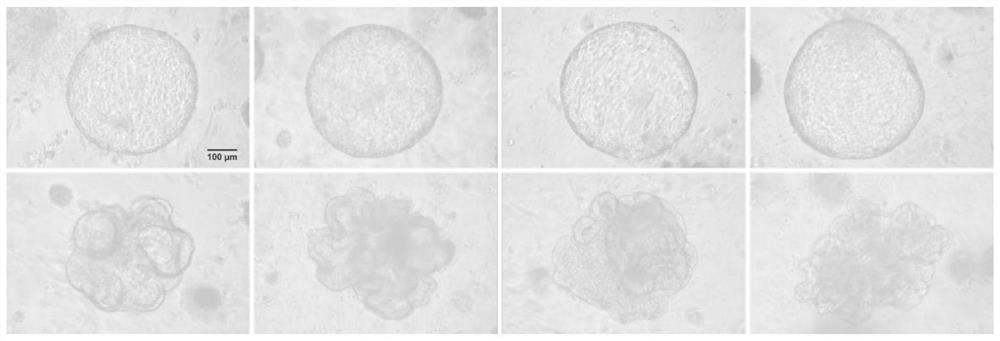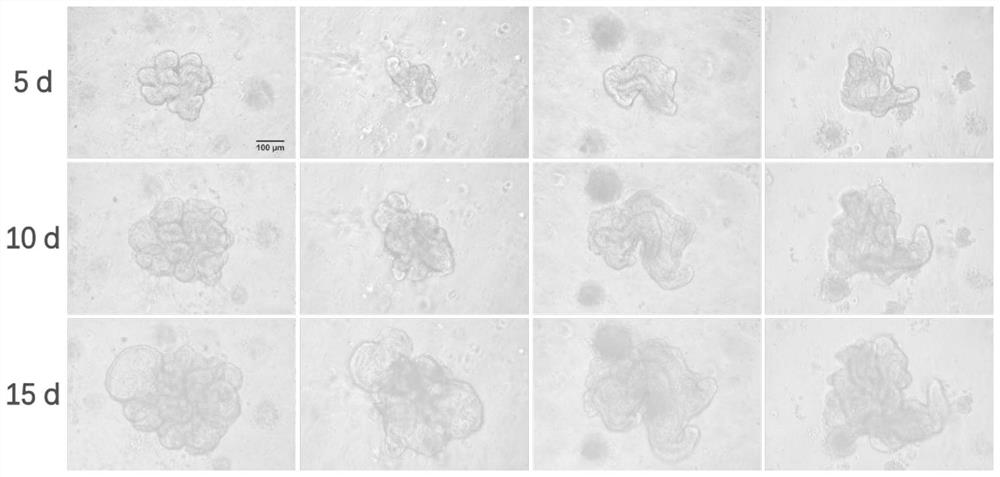Mouse lung organ culture method
A technology of organ culture and organoids, applied in the field of cell biology, can solve the problems of low formation rate of lung organoids, difficult manipulation and cumbersome culture process, etc., shorten the in vitro culture period, shorten the culture period, and simplify the experimental steps Effect
- Summary
- Abstract
- Description
- Claims
- Application Information
AI Technical Summary
Problems solved by technology
Method used
Image
Examples
Embodiment 1
[0052] Firstly, adopt the method shown in CN111534477A to cultivate the primary epithelial stem cell spheres of mouse lung tissue (that is, the following steps 1 to 10).
[0053] (1) Thoroughly disinfect the skin of the mouse with 75% alcohol, aseptically separate the lung tissue and rinse it in pre-cooled sterile PBS (phosphate buffered saline solution), remove the connective tissue and the main bronchus in the lung, and separate the lung lobes at the same time, Wash 2-3 times to remove blood.
[0054] (2) Transfer the cleaned lung lobe to a new cell culture dish with sterile tweezers, suck off the residual PBS, and use ophthalmic surgical scissors to evenly cut the lung tissue into about 1mm 3 The tissue pieces were transferred to the preheated collagenase digestion solution and digested on a constant temperature shaker (100 rpm) at 37°C for 45-60 minutes;
[0055] (3) Add an equivalent amount of DMEM / F12 medium containing 10% FBS to stop the digestion, pipette and mix well, ...
Embodiment 2
[0075] In this example, the effect of lung spheroids with different diameters on organoid culture was tested.
[0076] Such as Figure 6 As shown, the lung spheroids Figure 6 Left); lung spheroids > 80 μm were used for subsequent organoid culture, and organoids with obvious hollow and branched structures could not be formed ( Figure 6 right). Only when the lung spheres of 50-80 μm are selected, can the hollow and circular alveolar organoids and lung bud organoids that spontaneously realize the morphological development and differentiation of the lungs be formed.
PUM
 Login to View More
Login to View More Abstract
Description
Claims
Application Information
 Login to View More
Login to View More - R&D
- Intellectual Property
- Life Sciences
- Materials
- Tech Scout
- Unparalleled Data Quality
- Higher Quality Content
- 60% Fewer Hallucinations
Browse by: Latest US Patents, China's latest patents, Technical Efficacy Thesaurus, Application Domain, Technology Topic, Popular Technical Reports.
© 2025 PatSnap. All rights reserved.Legal|Privacy policy|Modern Slavery Act Transparency Statement|Sitemap|About US| Contact US: help@patsnap.com



